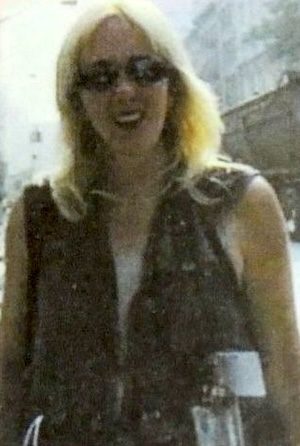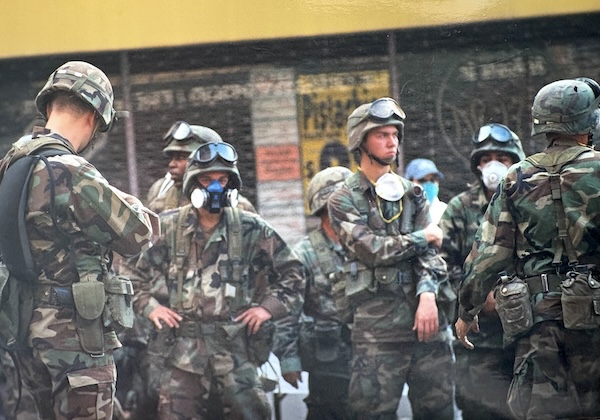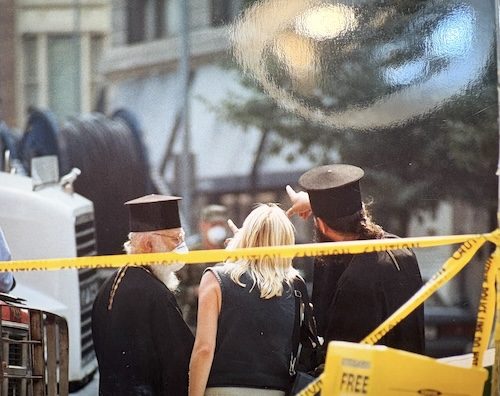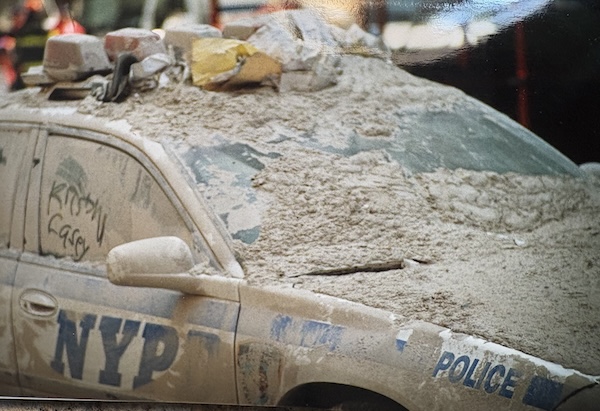By Wendy Post —
On Sept. 11, 2001, the country watched in horror as 19 terrorists from the Islamist extremist group al-Qaeda hijacked four planes, deliberately crashing two of them into the World Trade Center’s Twin Towers and another into the Pentagon, while a hijacked plane crashed in a field near Shanksville, Pa. leaving nearly 3,000 people dead.
For those old enough to remember that fateful morning that left the nation in shock, they might also recall exactly where they were when they heard the news.
For this writer, I was working for the Department of Defense and was in a coworker’s cubicle when a pop-up showed the first plane slamming into one of the World Trade Center towers. This was followed by another plane, and then another.

Wendy Post is pictured near Ground Zero following the attacks on Sept. 11, 2001. Post was serving with the Department of Defense and was also contributing to The Owego Pennysaver Press with her coverage. (File Photo / Wendy Post)
The terror continued, with the first plane crashing into the North Tower in Lower Manhattan at 8:46 a.m.; the second crashing into the South Tower at 9:03 a.m.
At 9:37 a.m., a flight crashed into the Pentagon, and at 10:03 a.m., another flight crashed into a field near Shanksville, Pa., and after the passengers and crew stormed the cockpit.
By 10:30 a.m., both towers had collapsed in Manhattan, and five other buildings were destroyed due to damage from the towers.
Upon word of the attacks, I began planning a trip to the city to report on what was taking place: stories that would be published in defense publications as well as locally.
The drive to the city was a bit eerie, with a certain silence in the air that couldn’t be described; maybe a nation in shock was a factor. Vehicles were already brandishing American flags in an act of solidarity.
Stopping only for coffee along the way, and with a friend who accompanied me along the way, I eventually arrived at the outskirts of the perimeter that surrounded portions of New York City and directly surrounded the World Trade Center.

Military presence was heavy in Manhattan following the attacks there on Sept. 11, 2001. (Photo by Wendy Post)
With a military and government ID in hand, as well as press credentials, I began the trek through multiple security roadblocks and barriers, all on foot.
Although blocks away from what was referred to as “Ground Zero,” layers of dust blanketed everything along the way. Police cars, buildings, light poles, and everything located within the perimeter were covered with two to three inches of ash.
Once at Ground Zero, a pool of journalists stood alongside the interior perimeter as workers in hazmat suits combed through the debris, searching for any survivors. Working dogs were also involved in the search operation.
In the end, there were no survivors to be found. An eerie photo of a nearby hospital lined with volunteers, ready to help, shocked the nation. They stood ready to serve, but there were no bodies being recovered. Everything had turned to dust.
I recall another scene where a volunteer had worked for over 24-hours to assist. He was sitting on a dust-filled curb; first responders were tending to him, encouraging him to take some time off from his efforts to rest.
As the residual damage began, with several other buildings collapsing, the media kept getting pushed back for safety reasons.

Wendy Post and some of the area residents watched as another building was about to collapse following the attacks on the World Trade Center’s Twin Towers on Sept. 11, 2001. (File Photo / Wendy Post)
Proper gear, however, was short in supply at the scene, with many who worked in various capacities at the site, such as the media, being offered N95 masks. Unfortunately, it wasn’t enough. Many suffered illnesses following 9/11, with toxins being responsible for various cancer-related deaths.
To this date, I have been dealing with my own chronic ailments that began immediately following my return from Manhattan on Sept. 13. But it is not nearly as devastating as the loss that happened that day, and the tens of thousands who have died from 9/11-related illnesses caused by exposure to toxic dust at Ground Zero, illnesses that include various cancers, respiratory conditions like asthma and chronic obstructive pulmonary disease (COPD), and mental health conditions such as PTSD.
Back in Owego, a group of first responders was getting ready to head to the city. I was invited to brief the group at the Public Safety Building prior to their departure and emphasized the importance of personal safety equipment, items not readily available in Manhattan.
As far as the scene, it was apocalyptic, with landmarks unidentifiable due to the dust and debris. There was a heavy military and FBI presence as officials moved swiftly with their investigations.
Normally a bustling city, the streets were empty; there was no traffic, and cell phone service was non-existent as all of the signals were jammed. Sitting at an outdoor table at a Mexican restaurant in Greenwich Village, which was at the edge of the cordoned-off perimeter, I was once again taken aback by the absence of traffic; not a single car was in sight in the normally bottlenecked streets.
The cleanup of the site was a massive effort that took ten months and involved the removal of millions of tons of debris. The cleanup effort was conducted under the supervision of the Army Corps of Engineers and other agencies, with its immense scope leading to ongoing health concerns for the workers exposed to toxins in the debris.
Today, a 9/11 Memorial Museum is erected where the Twin Towers once stood, telling visitors the story of what happened.
Locally, the Town of Owego’s 9/11 Memorial is located in Hickories Park and features a tribute to the victims of the 9/11 attacks, including salvaged World Trade Center steel from PATH train tracks. The memorial also includes state trees representing the affected locations of New York, Pennsylvania, and Virginia.
A bench placed at the memorial carries the name of 30-year-old Tioga County resident Derek James Statkevicus, who was one of the 2,977 lives lost that day. Statkeviscus was a Vestal High School alum and Ithaca College graduate who worked in an office located on the 86th floor of the World Trade Center’s South Tower.
On Thursday, Sept. 11, a memorial and remembrance ceremony took place in a solemn tribute of remembrance.
The service held each year in the town of Owego on 9/11 offers a remembrance of these events. Missed at this year’s service, I might note, is Ken Easton, who passed in 2025. In 2002, Easton led an effort to raise funds to benefit a scholarship for a fallen firefighter from New York City. Years later, Easton also brought the 9/11 Memorial exhibit to Owego, offering education on the events that took place that day.
We must never forget. It is hoped that efforts like Easton’s to educate and continual ceremonies of remembrance will pay homage to those who lost their lives on 9/11.
(Wendy Post is the current editor of The Owego Pennysaver Press, an Army veteran and paratrooper, and has served as a writer for various Department of Defense publications. Post was working for the Department of Defense and as a freelance writer for The Owego Pennysaver in September of 2001.)



Be the first to comment on "Remembering 9/11"